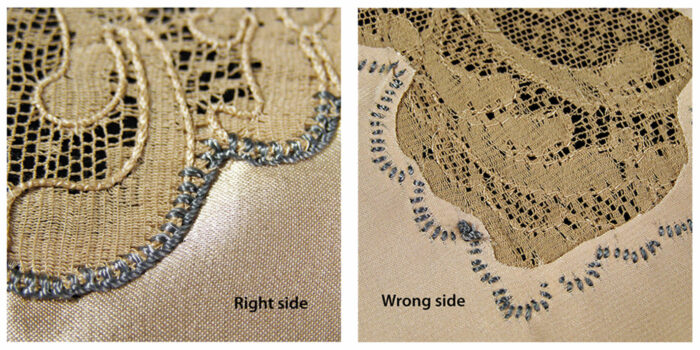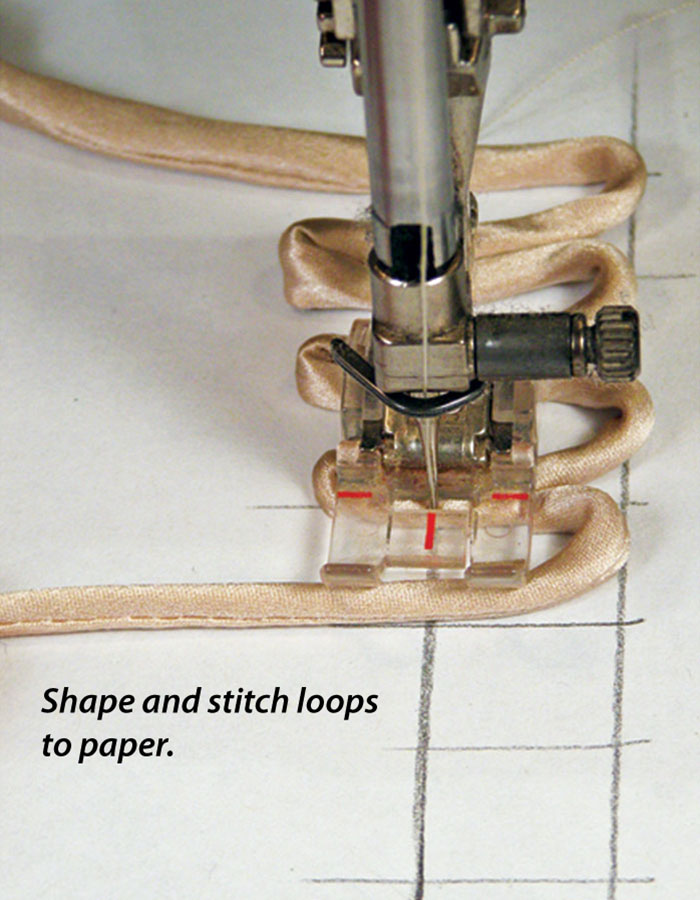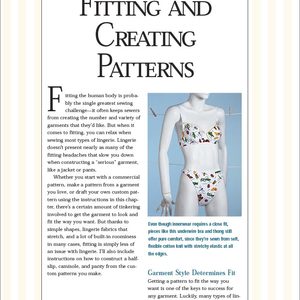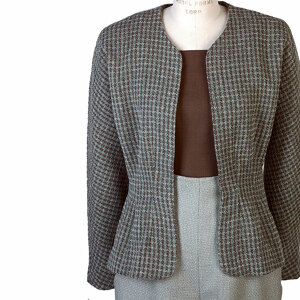Sewing Techniques to Create Luxurious Couture Lingerie
Learn lingerie sewing techniques from Alexandra Armillas who designed lingerie for Christian Dior.
The intricate beauty and delicacy of fine lace and lingerie have been great inspirations to me. Sewn by machine or by hand, couture lingerie is cut to fit and combines hand-selected and balanced lace with luxurious fabrics and delicately executed buttons and fittings.
Here, I describe how I learned about couture lingerie and how you can make your own. I attended the Fashion Institute of Technology (F.I.T.) and interned at Christian Dior Lingerie during my senior year. When I graduated, Dior offered me a full-time position, and I received wonderful training in couture lingerie. The experience of working with extraordinary French laces—especially Alençon lace—and the finest cottons, silks, and novelty fabrics only reinforced my deep love of exquisite lingerie.

Later, after I worked for an innovative, contemporary company for several years and ran a small business that produced one-of-a-kind, couture lingerie from antique embroideries and silks, I again came to the attention of Christian Dior Lingerie—and a twenty-year stint as their head designer ensued. It was thrilling to create the concept of a lingerie collection— something that did not exist in the industry when I returned to Dior.
Evolving with Dior
Over time, the Dior line evolved to two-hundred-piece per year collections for each of its five markets. The fabrics and silhouettes covered an extensive variety of techniques that included tailored, yarn-dyed, striped pajamas with embroidered emblems accompanied by Savoy Row quality tailored robes; christening gowns in the finest cotton lawn or silk; and silk bridal sets with French lace appliqué accompanied by luxurious silk, velvet, or brocade robes. An even more opulent collection called “Dior Le Connoisseur” allowed me to create truly couture, extraordinarily complex originals, using many imported and gossamer components.
Designing for Dior required biannual visits to the House of Dior in Paris, which was always inspiring. My deep love of France and its culture, people, and decorative arts, grew on every trip. I also had the honor of designing and launching the Oscar de la Renta Sleepwear Collection and of working with one of the finest people in the fashion industry—a true icon.
What’s couture?
Couture lingerie is always worth the price. What is priceless is the sense of beauty and serenity an exquisite piece can impart to one’s sense of self, well being, and happiness. With loving care, a couture piece can last a very long time.
The average lingerie sold today is serviceable and readily replaced. Most pieces do the job of providing something to sleep in, which is quite different from creating an heirloom that inspires a transcendent state and sweet dreams. I have always believed the private, inner world of a woman is where her life should begin and that couture lingerie is an important part of this world.

A couture camisole is a truly versatile addition to any woman’s wardrobe. You can wear it to bed with a matching bikini, tap pants, or long pants for 1930s glamour. You can wear it to work under a suit or with a pair of jeans for an evening out with friends.
The techniques I demonstrate here are essentially the same as ones you would use to create a chemise, ballerina length gown, or long gown. You can use some of the lace steps to create other lingerie pieces such as matching robes or bodysuits.
Let silk and lace take form
The camisole shown here features French lace appliquéd on silk charmeuse with hidden bust darts. Once I have conceived the original design and chosen the lace, I photocopy the lace. This enables me to experiment with the design to get a preliminary feel for how I want the lace to come together without needlessly cutting up this expensive, precious commodity.
Every well-designed lace offers many design possibilities. Throughout my career, this has enabled me to use a favorite lace many times with completely different results.
In couture lingerie, the original garment is almost always draped in the actual fabric. Pure silk charmeuse drapes differently than polyester charmeuse. Time is better spent creating a good drape in a quality fabric than correcting an ill-fitting drape in a lesser fabric. Unless, of course, you’re using a $300- per-yard silk velvet or brocade.
As this camisole will be silk, the drape should be executed in silk. Allow at least 1-inch seam allowances at the side seams, to accommodate fitting.
Make an original design with lace
This beautiful French Alençon lace has a wonderful heirloom feel. I almost always work with a 3- to 6-inch-wide lace “galloon.” Galloon lace has scalloped edges on both sides and mirrored right and left motifs. Galloon enables me to create a design with symmetrical right and left sides.

Always allow 1 inch or so of extra lace at the side seams. Once you have used the photocopies to determine the composition you want to use, you can proceed to cut the actual lace.

Use delicate scissors to divide the scallops and motifs from the galloon. Cut along the corded edges of the motifs (called “gimps” or “liners”), and trim away the excess netting.
Cut the fabric and lace
Once you’re satisfied with the drape and the lace placement, transfer the draped silk shapes to paper, and trace your new custom-designed pattern. Next, cut out the camisole from the pattern.

Even if the lace is appliquéd to the front and back separately, at this stage, it is best to baste the cups and side seams together and then confirm the fit on a dress form.
If you must adjust the fit, now is the time to correct the pattern. Proceed if it looks beautiful on the form. The side seams must be exactly at the side seam. The camisole and lace are now ready to sew with your sewing machine or elegant hand stitches.
Position the lace
First, sew the darts in the cups, and close the center-front seam if your design has one. There is no need to finish these seams because after the lace is appliquéd over the seam and darts, the fabric backing is cut away.
Return the camisole bodice to the dress form, and pin the lace over the darts. Make sure that the left and right lace motifs are mirror images.
Stitch the appliqué
I use either a machine-sewn baby zigzag stitch or tiny hand-sewn blanket stitches to appliqué the lace to the charmeuse. Either way, use fine thread that matches the lace, and sew from the right side.

On your machine, set a narrow zigzag stitch about 1.5mm wide, drop the feed dogs, and use a free-motion presser foot. This will enable you to hand-guide the stitching, so it accurately follows the edges of the lace. Move the work slowly to get a short stitch length. Free-motion stitch the zigzag so it’s contained within the boundaries of the lace. To hand-sew the tiny blanket stitch, form minuscule stitches (see “Master Class: Master the Hand Stitch”) over the lace edge.

Assemble the front body
Appliqué the lace over the darts. Then, with curved appliqué scissors, cut the fabric from behind the lace, leaving 1/8-inch seam allowances all around.

Next, pin the lace around the neckline and arm edges on the front. Align the high point of the scallop with the raw fabric edge. At this stage, it is a good idea to pin the side seams together to check for fit again, as pinning the lace may have changed the fit. If all is well, continue to appliqué the lace on the right side of the camisole, and cut away the base fabric from the wrong side.
Next, pin the lace to the top of the front body. Align the highest point on the scallop with the raw fabric edge, and lap the front body over the bodice at the empire seam. Then, appliqué the lace, and trim away the fabric from behind it.
Finish the front lower edge
Pin the lace to the front hem. Next, pin the lace to the back body at the back neckline and hem. At this stage, re-pin the side seams to ensure that the lace matches perfectly at the side seams before you appliqué. Here’s where the galloon lace’s mirror-image design always enhances your creation. I adjust the lace so that it matches exactly at the side seam, which may make the join in the lace different at the center front and center back.
Construct the camisole
After you have appliquéd all of the lace as described but before you have closed the side seams, determine if you need loops and buttons, and attach them as described at far right. They are always on the left side. French seams are well suited to camisoles, as they produce a clean finish. As it is a short side seam, there is little risk of distortion.
Beautiful lingerie can enhance a woman’s quality of life and contribute a great sense of beauty and refinement. It is my wish that you will be inspired to create this couture camisole and experience a great sense of accomplishment and pride in your achievement.
Finishing touches
The final details are my passion. Couture lingerie is defined by an extraordinary attention to detail.
Button loops
Treat buttons as “jewelry” for your piece. They should subtly enhance your creation.
Straps
Adjustable straps keep your camisole fit flexible for subtle daily figure changes. Diminutive notions keep the look in character with the fine garment.

By Alexandra Armillas, Christian Dior lingerie designer. 
—Alexandra Armillas brings her couture expertise and acclaimed design experience to teaching at F.I.T. in New York City.
Photos: (model) Jack Deutsch, hair and makeup: Christy McCabe using tarte cosmetics, stylist: Jessica Saal; all others, Kenneth D. King.
From Threads #135







































Very good article, good design. Really showcases how FIT teaches...I also majored in Lingerie Design at FIT!!!
The designs are beautiful. Where can I find galloon lace? I have been looking for it after being inspired by this article but am having no luck.
I really liked this article...The lingerie is very pretty.
Thank you for the information. You're very talented. I want to attempt to make some vintage lingerie pieces. Hopefully, I'll be able to incorporate your ideas and suggestions into the construction of my garments. Thanks again.
An Excellent article about couture lingerie. For Pixistix, you can find galloon lace at house fabric.com Here is the link for one item in particular...
http://housefabric.com/ProductDetail.asp?ProductID=19199
Look under bridal lace for other selections. As well check with Mood Fabrics, here is the link...
http://www.moodfabrics.com/index.php?file=categorylist&icatid=29&imsmat_id=170&posms=9&frompage=menu
Instead of looking for 'gallon lace' which is an industry term, just look for lace and choose the symmetrical lace. It's quite common and is easy to find.
What is the momme? 28?
This remains one of my favorite Thread pieces, perhaps my favorite. The design, the construction, the styling, it's all there.
Always a will admire, the art in lingerie,
from Alexandra Armillas.
The rich touch of lace embroyderie,
and the style, and the cualities
of materials make this beatiful piece.
Am glad that you continue in the world
of art,
[b]Cheap Viagra, Cialis, Levitra[/b]
This service is powered by [url=http://www.kamagradeutschlandshop.com/]Kamagra Deutschland[/url]
[URL=http://en.generic4all.com/9586,0,0.dhtml?refID=9586][IMG]http://en.generic4all.com/images/banners/extended_performance_all_300x250_.jpg[/IMG][/URL]
[b]CLICK ON BANNER ABOVE AND VIEW OUR CHEAP PRICES. ENJOY[/b]
This is so beautiful. I really should try in a dove grey charmeuse... And it would be lovely to hear you talk more about Dior (the best couturier).
Amazing article , good look !
lool amazing